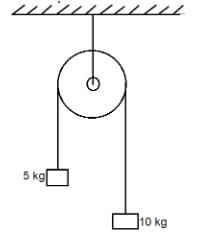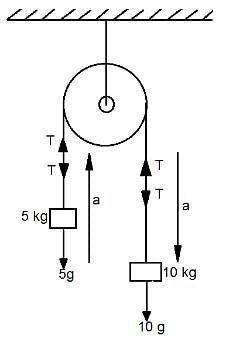JEE Exam > JEE Questions > In the figure given, two masses of 5 kg and 1...
Start Learning for Free
In the figure given, two masses of 5 kg and 10 kg are attached to a massless string and the string passes over an ideal frictionless pulley. The system is released from the rest at t = 0 sec. Find the work done by the string on the mass of 5 kg during the time t = 1 sec, just after releasing the system from the rest.

(use acceleration due to gravity, g = 10 m/s2)

(use acceleration due to gravity, g = 10 m/s2)
- a)-50 J
- b)-111 J
- c)50 J
- d)111 J
Correct answer is option 'D'. Can you explain this answer?
| FREE This question is part of | Download PDF Attempt this Test |
Most Upvoted Answer
In the figure given, two masses of 5 kg and 10 kg are attached to a ma...
From the FBD below

Acceleration of the blocks in the given problem

From the equation of motion

From FBD
Let the tension in the string is T

Work done by tension


Acceleration of the blocks in the given problem

From the equation of motion

From FBD
Let the tension in the string is T

Work done by tension

Free Test
FREE
| Start Free Test |
Community Answer
In the figure given, two masses of 5 kg and 10 kg are attached to a ma...
Option d
Attention JEE Students!
To make sure you are not studying endlessly, EduRev has designed JEE study material, with Structured Courses, Videos, & Test Series. Plus get personalized analysis, doubt solving and improvement plans to achieve a great score in JEE.

|
Explore Courses for JEE exam
|

|
Similar JEE Doubts
In the figure given, two masses of 5 kg and 10 kg are attached to a massless string and the string passes over an ideal frictionless pulley. The system is released from the rest at t = 0 sec. Find the work done by the string on the mass of 5 kg during the time t = 1 sec, just after releasing the system from the rest.(use acceleration due to gravity, g = 10 m/s2)a)-50 Jb)-111 Jc)50 Jd)111 JCorrect answer is option 'D'. Can you explain this answer?
Question Description
In the figure given, two masses of 5 kg and 10 kg are attached to a massless string and the string passes over an ideal frictionless pulley. The system is released from the rest at t = 0 sec. Find the work done by the string on the mass of 5 kg during the time t = 1 sec, just after releasing the system from the rest.(use acceleration due to gravity, g = 10 m/s2)a)-50 Jb)-111 Jc)50 Jd)111 JCorrect answer is option 'D'. Can you explain this answer? for JEE 2024 is part of JEE preparation. The Question and answers have been prepared according to the JEE exam syllabus. Information about In the figure given, two masses of 5 kg and 10 kg are attached to a massless string and the string passes over an ideal frictionless pulley. The system is released from the rest at t = 0 sec. Find the work done by the string on the mass of 5 kg during the time t = 1 sec, just after releasing the system from the rest.(use acceleration due to gravity, g = 10 m/s2)a)-50 Jb)-111 Jc)50 Jd)111 JCorrect answer is option 'D'. Can you explain this answer? covers all topics & solutions for JEE 2024 Exam. Find important definitions, questions, meanings, examples, exercises and tests below for In the figure given, two masses of 5 kg and 10 kg are attached to a massless string and the string passes over an ideal frictionless pulley. The system is released from the rest at t = 0 sec. Find the work done by the string on the mass of 5 kg during the time t = 1 sec, just after releasing the system from the rest.(use acceleration due to gravity, g = 10 m/s2)a)-50 Jb)-111 Jc)50 Jd)111 JCorrect answer is option 'D'. Can you explain this answer?.
In the figure given, two masses of 5 kg and 10 kg are attached to a massless string and the string passes over an ideal frictionless pulley. The system is released from the rest at t = 0 sec. Find the work done by the string on the mass of 5 kg during the time t = 1 sec, just after releasing the system from the rest.(use acceleration due to gravity, g = 10 m/s2)a)-50 Jb)-111 Jc)50 Jd)111 JCorrect answer is option 'D'. Can you explain this answer? for JEE 2024 is part of JEE preparation. The Question and answers have been prepared according to the JEE exam syllabus. Information about In the figure given, two masses of 5 kg and 10 kg are attached to a massless string and the string passes over an ideal frictionless pulley. The system is released from the rest at t = 0 sec. Find the work done by the string on the mass of 5 kg during the time t = 1 sec, just after releasing the system from the rest.(use acceleration due to gravity, g = 10 m/s2)a)-50 Jb)-111 Jc)50 Jd)111 JCorrect answer is option 'D'. Can you explain this answer? covers all topics & solutions for JEE 2024 Exam. Find important definitions, questions, meanings, examples, exercises and tests below for In the figure given, two masses of 5 kg and 10 kg are attached to a massless string and the string passes over an ideal frictionless pulley. The system is released from the rest at t = 0 sec. Find the work done by the string on the mass of 5 kg during the time t = 1 sec, just after releasing the system from the rest.(use acceleration due to gravity, g = 10 m/s2)a)-50 Jb)-111 Jc)50 Jd)111 JCorrect answer is option 'D'. Can you explain this answer?.
Solutions for In the figure given, two masses of 5 kg and 10 kg are attached to a massless string and the string passes over an ideal frictionless pulley. The system is released from the rest at t = 0 sec. Find the work done by the string on the mass of 5 kg during the time t = 1 sec, just after releasing the system from the rest.(use acceleration due to gravity, g = 10 m/s2)a)-50 Jb)-111 Jc)50 Jd)111 JCorrect answer is option 'D'. Can you explain this answer? in English & in Hindi are available as part of our courses for JEE.
Download more important topics, notes, lectures and mock test series for JEE Exam by signing up for free.
Here you can find the meaning of In the figure given, two masses of 5 kg and 10 kg are attached to a massless string and the string passes over an ideal frictionless pulley. The system is released from the rest at t = 0 sec. Find the work done by the string on the mass of 5 kg during the time t = 1 sec, just after releasing the system from the rest.(use acceleration due to gravity, g = 10 m/s2)a)-50 Jb)-111 Jc)50 Jd)111 JCorrect answer is option 'D'. Can you explain this answer? defined & explained in the simplest way possible. Besides giving the explanation of
In the figure given, two masses of 5 kg and 10 kg are attached to a massless string and the string passes over an ideal frictionless pulley. The system is released from the rest at t = 0 sec. Find the work done by the string on the mass of 5 kg during the time t = 1 sec, just after releasing the system from the rest.(use acceleration due to gravity, g = 10 m/s2)a)-50 Jb)-111 Jc)50 Jd)111 JCorrect answer is option 'D'. Can you explain this answer?, a detailed solution for In the figure given, two masses of 5 kg and 10 kg are attached to a massless string and the string passes over an ideal frictionless pulley. The system is released from the rest at t = 0 sec. Find the work done by the string on the mass of 5 kg during the time t = 1 sec, just after releasing the system from the rest.(use acceleration due to gravity, g = 10 m/s2)a)-50 Jb)-111 Jc)50 Jd)111 JCorrect answer is option 'D'. Can you explain this answer? has been provided alongside types of In the figure given, two masses of 5 kg and 10 kg are attached to a massless string and the string passes over an ideal frictionless pulley. The system is released from the rest at t = 0 sec. Find the work done by the string on the mass of 5 kg during the time t = 1 sec, just after releasing the system from the rest.(use acceleration due to gravity, g = 10 m/s2)a)-50 Jb)-111 Jc)50 Jd)111 JCorrect answer is option 'D'. Can you explain this answer? theory, EduRev gives you an
ample number of questions to practice In the figure given, two masses of 5 kg and 10 kg are attached to a massless string and the string passes over an ideal frictionless pulley. The system is released from the rest at t = 0 sec. Find the work done by the string on the mass of 5 kg during the time t = 1 sec, just after releasing the system from the rest.(use acceleration due to gravity, g = 10 m/s2)a)-50 Jb)-111 Jc)50 Jd)111 JCorrect answer is option 'D'. Can you explain this answer? tests, examples and also practice JEE tests.

|
Explore Courses for JEE exam
|

|
Suggested Free Tests
Signup for Free!
Signup to see your scores go up within 7 days! Learn & Practice with 1000+ FREE Notes, Videos & Tests.
























